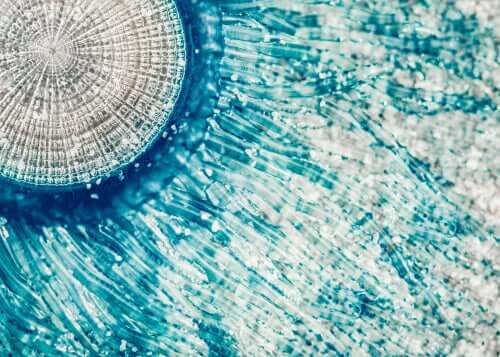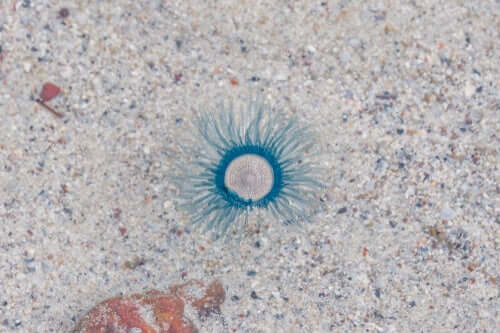Porpita Porpita, the Blue Button Jellyfish

The blue button jellyfish, better known as Porpita porpita, is a bright-colored vertebral that, despite its name, isn’t a jellyfish. So, where does this confusion come from?
Porpita porpita, the blue button jellyfish
The Porpita porpita is called ‘blue button jellyfish‘ despite not being a jellyfish, but a hydra. In itself, a blue button jellyfish is part of a colony of hydroids.
Porpita porpita has an organization similar to the Velella species. It’s also a pelagic organism, which floats on or near the surface of the sea.
This species has a large number of tentacles and a diameter of 1 inch in length when the disc is flat. Its tentacles have a translucent blue tonality, while the edge is dark blue.
An individual’s body is made up of the union between the hydroid colony and a buoy. Therefore, the floating body of the Porpita porpita is round and almost flat, with a golden brown color.
As for the color of the hydroid colony, it varies from a yellow tone to a bright turquoise blue. This hydroid colony is quite tentacle-like, making it look similar to a jellyfish.
Each of the “tentacles” consists of a large number of branches. And, at the tip of each branch, are cells that contain venom, the nematocysts.

Distribution and habitat
The blue button jellyfish is found in the North Atlantic Ocean and the Western and Eastern Mediterranean Sea. They prefer the temperate waters that extend from Europe to the Gulf of Mexico and the south of the USA.
Although this creature normally lives on the surface of the ocean, it can sometimes reach the shore. For this reason, they have been seen by bathers on beaches or in coastal areas.
Feeding and reproduction of the blue button jellyfish
The blue button jellyfish is a passive organism that moves with the ocean streams. However, it competes with other small passive organisms for food.
They usually eat small crustaceans that are part of plankton and crustacean larvae. Their mouths have a dual functionality – to eat food and remove waste.
Their reproduction is one thing worth discussing, as they’re hermaphrodites, meaning that they have both male and female sexual organs.
Therefore, they release eggs and sperm during fertilization. The first step is the transformation into larvae and then into polyps.
Once the polyp has developed, it joins the colony of hydroids that make up the individual. In itself, the colony is formed by the union of emerging polyps that divide to form new polyps.
Porpita porpita trivia
A blue button jellyfish’s sting isn’t overly harmful to humans, but it does irritate. Therefore, it’s best to avoid contact with this creature.

Jellyfish store the poison in cells located in tentacles called ‘cnidoblasts’. These stinging cells, called ‘cnidoblasts’ or ‘nematocysts’, are used to capture prey or as defensive tactics.
When a jellyfish stings a person, it usually just irritates the skin. But how do you remedy a sting from this jellyfish?
First of all, try to avoid removing the tentacles with your bare hands. You need to cover your hands when removing tentacles and other possible fragments.
Do this using warm seawater or sand, which will help reduce the pain of the sting. You can also apply cold compresses alternating between vinegar or lemon compresses.
If you’re near a relief center on the beach, you should go to them because they’ll know how to act properly. Don’t apply alcohol, urine, freshwater, or hot water.
The ocean is home to many curious creatures such as the blue button jellyfish, another reason to look after our planet’s oceans and keep them as clean as possible.
All cited sources were thoroughly reviewed by our team to ensure their quality, reliability, currency, and validity. The bibliography of this article was considered reliable and of academic or scientific accuracy.
-
V.K A. Zoology for Degree Students B.Sc. First Year. S. Chand Publishing; 2011. pp. 207-208 Disponible en: https://books.google.es/books?id=FjJlDwAAQBAJ&pg=PA207&dq=Porpita+porpita&hl=es&sa=X&ved=0ahUKEwjvqqz23KnoAhXABGMBHUMrCNkQ6AEIUjAE#v=onepage&q=Porpita%20porpita&f=false
-
Botón azul [Internet]. Medusas. [citado 23 de marzo de 2020]. Disponible en: http://www.medusas.org/boton-azul
-
Medusa botón azul: Características, alimentación [Internet]. Medusas Wiki. 2016 [citado 23 de marzo de 2020]. Disponible en: https://medusas.wiki/medusa-boton-azul/
This text is provided for informational purposes only and does not replace consultation with a professional. If in doubt, consult your specialist.